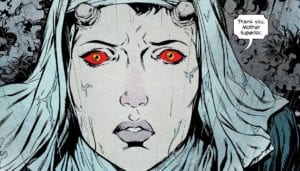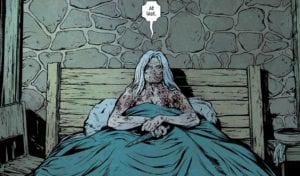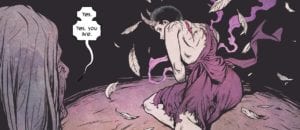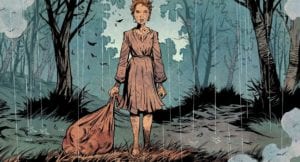There’s something special about WicDiv one-shots. They have a pattern and a very distinct kind of narrative: after each arc, we take a leap back in time to get a lost piece of the big picture. At the beginning of each new arc, the truth becomes clearer to us. The latest arc, Mothering Invention, has introduced something of a spanner in those works with the occasional flashbacks to ancient times, to the bloody days of Ananke and the first Persephone. By now, there is comparatively little we don’t know.
For centuries, Ananke has continued to preserve her existence by sacrificing Gods in each Recurrence and inhabiting Minerva’s physicality to ensure the next cycle happens without a hitch. Ancient Persephone’s gambit is for somebody to eventually break that cycle by taking advantage of the rules to the game between the two Goddesses. So, what’s new this time around? Strictly speaking: not much. But do we really need a reason, a morsel of truth, to have a one-shot? Can we not just enjoy a story of doom and despair, beautifully illustrated by guest artist Ryan Kelly (of Lucifer, Local and New York Four fame)?
Yes, yes we can, dear reader.
Also because this may just feature my favourite Lucifer so far.
1373 AD
“This is my body… which is given for you.”
Naturally, spoilers ahead.
This story takes place in Avignon, France in the year 1373, which is telling enough about the setting: Roman Catholicism and heaps of death from the Bubonic Plague. As per WicDiv tradition, the icons on the prologue circle reveal the Gods remaining: Lucifer and Minerva. This means we arrived late to the party, and the Maiden-Crone duo probably have all they need for their ritual. Still, this is an interesting subversion since Lucifer tends to be one of the first Gods to bite the dust in this comic series.
The first thing that comes to topic proper here is the design. Kelly’s pens are as sharp for detail as always. The rainy, grey-blue choice of inks helps enhance the dready atmosphere, and it also does wonders when it comes to contrasts – for example, when looking at (gorgeous) Sister Lucifer’s hell-red eyes. However, the contrast extends also beyond colour and into how detailed the plague’s sores on the general population are. Furthermore, Lucifer’s Hellboy-esque sheared horns add an unsettling, painful tint to the Sister’s beauty. This very much falls in line with the contemporary ways of modesty and self-repression.
On to the story now. At the behest of the Mother Superior, Sister Lucifer greets a messenger – a young girl with an ailment of her own – who has come seeking she who walks through the plague untainted. In a matter of two panels, we get the nature of this Recurrence’s Lucifer. Despite becoming the incarnation of evil (according to the Catholic paradigm), she is very much a devout person, and believes that nobody is irredemeable. The messenger comes on behalf of another, an old, very sick woman who wishes to give confession. Being the only one untouchable by the plague, Lucifer is the one to call.

After a two days’ travel, they arrive at their destination. But a wild pack of flagellants, foreign to the village, has shown up. These folk believe that self-harm will spare them from the disease. It has not worked brilliantly, as they’re very obviously ill. The Good Sister tells the young girl to wait while she handles the situation. Now, things are looking pretty bleak in this little affair. The flagellants don’t look kindly upon the church, let alone the “Devil Girl”. What follows is an unpleasant show of implied and explicit carnal punishment. After mentioning that she had already been burned at the stake, to no effect, she disrobes herself nude.
The scars on her back reveal herself to have been a flagellant herself.
But neither the nudity, nor the usage of the proverb “do to me as you would have done unto you” leads to any sultriness – something which has become something of a trope in several indie comics and mediums. No, Sister Lucifer sets herself to be lashed as the flagellants do to themselves. This she does to humble them, and evidence their hypocrisy. Their actions come out of vanity rather than actual wish for redemption. After telling them they will not live to see the next day, she encourages them to repent as they will. So, the Sister and the young messenger carry on without further disturbance.
Finally, at the village, Lucifer meets the old woman, whose sight vexes her. Despite being severely marked by the plague, she is still very much alive. This is Ananke, and she has summoned Lucifer to know why, after two years, the Devil Girl is still sane, quite unlike her 455 ADD counterpart. This exchange is pretty revealing about French Lucifer. In spite of witnessing the diversity of the Pantheon, she deems her peers ‘false Gods’. Regardless of what she’s experienced, she still abides to the narrative of her belief and hopes for a peaceful afterlife. But Ananke knows better about such matters.

Ananke still claims that Lucifer will eventually go mad and cause great disaster. But Sister Lucifer is stubborn like that, or maybe her worldview and faith (however rigid) makes her impervious to Ananke’s words. The old woman notes she’s always been troublesome one way or another. Lucifer realises in that moment that the Messenger that brought her here was the same girl who introduced her to Ananke over two years ago. If you haven’t guessed already, yes – this is Minerva of this age, and she needed very little to convince the Sister to meet Ananke.
The old Goddess notes this has never happened before. Even before Ananke dropped the big reveal on her, the young woman already knew she was Lucifer. Judging by the brief flashback of her ascension, she lashed her own back even before becoming the Devil Girl. Thus, it becomes obvious just how heavy the burden of faith has been on the young woman. Or has it? Later in the conversation, Lucifer tells of her human birth. Her mother died from the plague, but the child lived. It was basically a miracle. But her father did not see it that way. He thought it should have been the child who died, and he never let her forget that. As foul a parent as the plague itself.
Thus… Lucifer, the Unforgiven. I’m gonna go off on something of a tangent here, but I’m a bit infatuated with this Lucifer as a character. So, let me have this. While the Christian view will always hold Lucifer as sire of all evils, one must never forget they were also an angel, a light bringer originally. This duality lives reversed in Sister Lucifer. She is deemed a devil in origin, but her choice to take on the religious office turns her into a light bringer. A rather dim light, but a light all the same. All of the things she says about redemption, those are not hollow words. But she still, tragically, does not recognise that switch in her. Perhaps because that would be vanity and pride, vices associated with the Devil.

Okay, tangent over. Ananke confesses, meaning she spells out all of her plan to Lucifer. This means, what she’s been up to from the beginning, her goal, and her part in the deaths of all the Gods. But, she does keep one thing to herself: Minerva’s role. Then, a bonus. Ananke got bored from how the world was coming along, so she essentially took action to prune civilisation a bit. When asked on how the plague started, Sister Lucifer alludes to what most believe, either the miasma, or the poisoning of the wells. She herself believes her own birth caused the plague.
Ananke dashes all of it by revealing the truth. Someone from the last Pantheon created the disease as an experiment. Then, to test it, the Old Goddess boarded the tainted ship in Crimea and sailed it herself to Italy. That’s right, Ananke imported the Black Plague with her own immune flesh. She is responsible for a far, far greater number of deaths than just Lucifer’s peers. The true devilry has been lifted off Lucifer’s shoulders, but there is no relief to be had. The Devil Girl, with Ananke’s knife in her hands, looks on the old woman with murderous eyes.
At this point, we’d expect savage comeuppance, no different than the carnage Ananke unleashed on her sister all those centuries ago. But Lucifer is not Ananke. The Good Sister pierces the palm of her own hand with the knife and extracts a bit of her own flesh. You can see where this is going… The Transubstantiation of Lucifer, blasphemous as all Hell… and oddly not at the same time. Placing her flesh in Ananke’s mouth, Lucifer completes the communion by burning Ananke and herself to death in Hellfire. The words she spoke while being lashed earlier, “Father, forgive me”, return with a darker reprisal. The comic’s cover doesn’t do the real thing justice, does it?
Unforgiven no more, this is Lucifer Redeemed, burning for the sins of Ananke.
All the while Minerva looks on from the distance, with a full bag in hand…

So, that’s it for this special one-shot, and at the risk of letting my loud-as-thunder voice permeate this review… HOW THE HELL DOES KIERON GILLEN UP HIS GAME EVERY DAMNED TIME, ESPECIALLY WHEN IT COMES TO THESE ONE-SHOTS!? Of course, this is just a personal opinion. While I can’t think of any actually inferior one-shot, the quality curve with these special issues has been, for me, consistently rising. I wouldn’t be surprised if another future one.shot (if it were to happen) could take the top spot in my favourites. But for now, this is definitely my favourite WicDiv one-shot. And this is my favourite Lucifer, period.
And who knows, when it comes to comics, Kieron Gillen may just have become my favourite.
Sorry, Neil.
The Wicked + The Divine 1373 AD Credits
Writer: Kieron Gillen
Art / Cover: Ryan Kelly, Jamie McKelvie, Matt Wilson
Images courtesy of Image Comics

